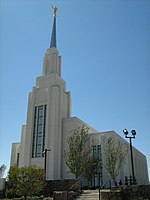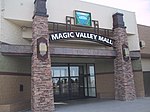Shoshone Falls

Shoshone Falls () is a waterfall in the western United States, on the Snake River in south-central Idaho, approximately three miles (5 km) northeast of the city of Twin Falls. Sometimes called the "Niagara of the West," Shoshone Falls is 212 feet (65 m) in height, 45 feet (14 m) higher than Niagara Falls, and flows over a rim nearly one thousand feet (300 m) in width. Formed by the cataclysmic outburst flooding of Lake Bonneville during the Pleistocene ice age about 14,000 years ago, Shoshone Falls marks the historical upper limit of fish migration (including salmon) in the Snake River, and was an important fishing and trading place for Native Americans. The falls were documented by Europeans as early as the 1840s; despite the isolated location, it became a tourist attraction starting in the 1860s. At the beginning of the 20th century, part of the Snake River was diverted for irrigation of the Magic Valley. Now, the flows over the falls can be viewed seasonally based on snowfall, irrigation needs and hydroelectric demands. Irrigation and hydroelectric power stations built on the falls were major contributors to the early economic development of southern Idaho. The City of Twin Falls owns and operates a park overlooking the waterfall. Shoshone Falls is best viewed in the spring, as diversion of the Snake River can significantly diminish water levels in the late summer and fall. The flow over the falls ranges from more than 20,000 cubic feet per second (570 m3/s) during late spring of wet years, to a minimum "scenic flow" (dam release) of 300 cu ft/s (8.5 m3/s) in dry years.
Excerpt from the Wikipedia article Shoshone Falls (License: CC BY-SA 3.0, Authors, Images).Shoshone Falls
Canyon Rim Trail, Twin Falls
Geographical coordinates (GPS) Address Nearby Places Show on map
Geographical coordinates (GPS)
| Latitude | Longitude |
|---|---|
| N 42.595277777778 ° | E -114.40083333333 ° |
Address
Canyon Rim Trail
83303 Twin Falls
Idaho, United States
Open on Google Maps




